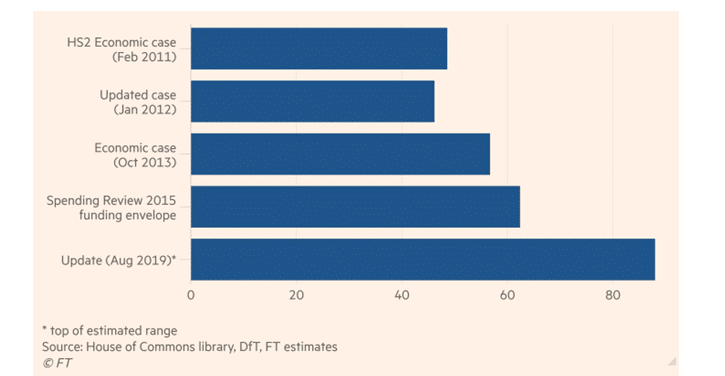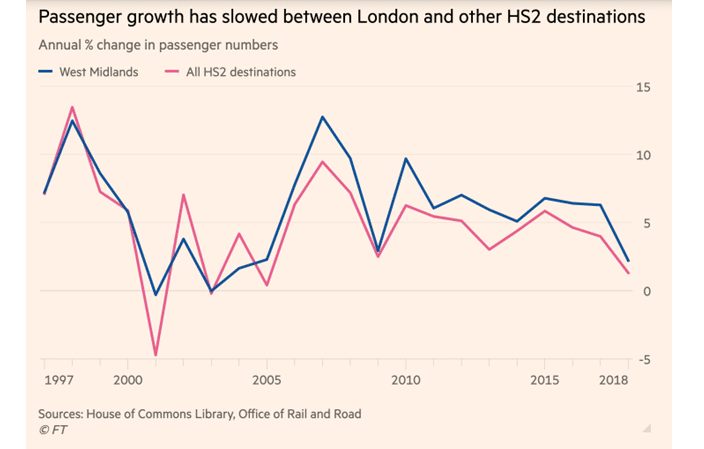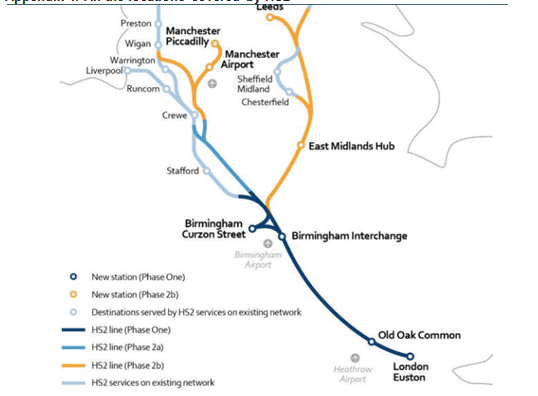HS2 ANALYTICAL REPORT
Executive Summary
This analytical report is concentrating on determining critical aspects which are responsible for delaying the project. The project has gained prominence for sustainable and ethical issues that are prevailing from the initial years. HS2 is not only damaging the environment as the project has been delayed by 5 years due to different factors but is also affecting the local people as well.
HS2 has failed to make either political or economical sense as it not only has an extremely low cost benefit ratio even if it is able to complete the project within the budget. The HS2 project has gained negative limelight because of its complete disregard of sustainable and ethical issues.
The introduction of new rail line, named as High Speed 2 is not beneficial to stakeholders, society, as well as environment and not even for the British Government. It is severely impacting on the governmental funds as the cost of project is continuously increasing.
Introduction
High Speed 2 is one of the famous projects in the UK which has been going on for quite a few years. It has gained a bad reputation because of its unethical and unsustainable practice.
This is a partly planned high speed railway with its first phase is in the early stages of construction whereas future stages are waiting for approval. It is supposed to be located in Greater London, West Midlands along with North West as well as Yorkshire. This analytical report is going to focus on identifying both critical factors that are delaying the project along with sustainable and ethical issues that are prevailing in the project.
Identification of critical factors responsible for the delay of the project
HS2 is damaging the environment as the project has been delayed by 5 years due to different factors that are impacting on the local people as well. This project was proposed as it is believed that HS2 Ltd is expected to carry and transfer more passengers from conventional speed trains.
The trains that are supposed to travel at a top speed of HS2 are using minimum double as much energy in comparison to conventional speed trains. Additionally, it has been found out that HS2 Ltd has even acknowledged that there is a transport system that consumes lower carbon.
Based on the views of Smith and Zhou (2018), in the current condition of the earth, it is of utmost importance that carbon which is a non-renewable source of energy, cannot be wasted as the number of carbon products is depleting which needs to be addressed.
The managers working for the British’s flagship infrastructure based project are pointing out various causes for expanding costs of the controversial High Speed 2 that is a rail project.
One of the primary factors for the delay of the project is that they are not capable of digging out a straight line through the English countryside. According to the views of Dudley and Banister (2018), some of the most common reasons for being unable to dig in this line are because when they initially planned to work on that line, they did not consider various challenges that would be coming their way.
Some of the unanticipated drawbacks include passing through some porous salt mines along with chalky rubble as well as ancient forests. So the officials of the project pointed out that the 5 year delay was because the ground conditions were significantly more precarious than it has been previously anticipated (Bonard et al. 2019, February).
HS2 has failed to make either political or economical sense as it not only has an extremely low cost benefit ratio even if it is able to complete the project within the budget. However, it has been a long time that the budget has overrun for the past few years.
Additionally, it has been found out that even if the project is privatised and the English government does not have the needed standing yet it can enact a badly demanded overhaul. However, the undertaken project is still going to depend severely on governmental funds which are not bountiful at the moment because of the ongoing epidemic, Covid 19.
According to the views of Miller (2019, March), HS2 is more likely to destroy invaluable carbon absorbing habitats whether it is allowed to go on in its recent form. This project is going to destroy the very environment which is responsible for providing a solution to climate issues.
The HS2 is not only able to travel at the highest speed in all over the world as well as running well below the ground level or even in tunnels for two third of its total length from its first stoppage in Birmingham.
However, a few assumed costs soon increased out of control whereas not a single meter of track had been placed. In the initial phase, it has been declared that the estimated bill is standing on 26 billion Euros which has hiked up to 88 billion Euros (Ft.com, 2020).
The capital that has been considered for the construction for phase one, starting from London until West Midlands groundwork is calculated between “£15.4 billion and £17.3 billion, with a mean value of £16.3 billion” (Assets.publishing.service.gov.uk, 2020).
There has been the inclusion of construction risk which has been estimated for an additional £4.2 billion which has been put forward by HM Treasury Guidance (Gudmundssonet al. 2016).
On the other hand, the current estimate has doubled from the initial costs. The construction work is faced with various controversies ranging between both ethical and sustainable factors.
There is going to be the destruction of 900 homes along with 1000 trading services as well as 60 unparalleled old forests while construction is going to be completed (Ft.com, 2020).
The sudden blowing up of cost capital results into a decade full of both political as well as fiscal issues for the proposed railway. This project came into light when it was established as a replacement for a third runway at Heathrow region which can be considered as an extension of an already subsisting high speed rail link to Europe but without any direct connection.
Other than unforeseen ground complications with the conditions of ground, there are other critical factors like miscalculated land values as well as inferior governance which are also responsible for pushing up the price of the project.
The HS2 project was already under fire resulting from mismanagement along with a dispute over interests. HS2 Ltd, which a public tax payer capitalised body has also been charged with the deliverance of the project, stands accused of either unable to comprehend the monetary consequences of the engineering challenge.
Influenced by the views of Cornet et al. (2018), it had come into acceptance or even trying to keep the actual cost from the public knowledge. However, it can be stated that the delay has originally happened as the previous plan did not consider various factors like the impact of building through obtusely populated places which also has certain complicated geographical features.
In order to start a project, it is essential to investigate the site and make risk identification as well as the management report, which seemed to have not happened in the case of HS2.
Determination of fundamental ethical and sustainable issues
The HS2 project has gained negative limelight because of its complete disregard of sustainable and ethical issues. In a construction project, it is common the environment gets harshly affected by waste materials and various other factors.
However, in the current world, it is essential to incorporate as many environment friendly actions so that there is an exposure to a controlled amount of carbon footprint. The aforementioned taxpayer funded organisations have even claimed that they are going to deliver a railway project by providing utmost respect to the natural environment.
The above stated company has every intention to conserve, replace and even enhance the wildlife habitats where a new green corridor is going to be built along with the under construction route (McNaughton, and Banks, 2019, March).
Moreover, the organisation has claimed to provide a high speed rail travel with as little carbon as possible. It has been found out in the official website of the respective entity that HS2 is going to offer long distance journey which is going to provide an alternative to other commute options like car and plane.
It is going to be a greener replacement to travel with the lowest emissions of carbon per passenger per kilometre. The difference is supposed to be 7 times less compared to cars as well as 17 times less than domestic air travel (Hs2.org.uk, 2020).
In the case of woodland, it has been found out that 52,000 kilometres of ancient forest sites in the UK are present among which 43 are going to fall in the route established between London and Crewe. The organisation has claimed that they are going to try to protect around 80% of the total area of these sites.
It has delegated “a £7 million HS2 Woodland Fund ” in order to restore the subsisting ancient woodlands or even formulate new woodlands which are either going to connect or extend to the previous woodlands (Hs2 Action Alliance.org, 2020).
Furthermore, the above stated organisations have decided on the ambition of establishing the most “sustainable high speed railway” which is one of its kinds in the whole wide world.
The organisation has also expressed that this railway network is going to support the economy, produce jobs, reduce carbon footprint and also offers reliable travel in this dynamic climate of the 21st century and after that as well.
However, HS2’s actions and inactions have showcased that it has the capacity to destroy the carbon capturing habitats present in England if it is being allowed by the British Government in its current form. Based on the views of Sun et al. (2017), it is not only going to damage the ecosystem but also ceases to provide a natural solution to the climatic emergency.
In recent years, the environment is constantly under threat which is ultimately impacting on the climate. Deforestation is one of the key causes for lack of environmental stability as it has increased carbon content on air which can be consumed by trees.
However, HS2 is advertised as an environment friendly way of travelling as mentioned above in the paragraph. The aforementioned project is not acting according to its claim as it has yet to support them. It has been highlighted by Watson et al. (2019, February), HS2 is going to have a far reaching impact on the environment that is mostly negative.
On the other hand, as the generation of electricity decarbonises, not only HS2 journeys are going to progress with low carbon. In addition, it has been stated that with the help of electricity generation being fully decarbonised, HS2 is going to be completely zero carbon.
The aforementioned project originally stated that the construction and after that the utilisation of this transport system is going to lessen the demand for domestic aeroplanes.
It was previously promoted as a segment of low carbon future, but the outcome provided by the company is stating otherwise which has run the project into different controversies. H2S still has not provided any fool proof documentation that they have not reduced carbon emissions.
In an analysis conducted by HS2 Ltd., it has been found out that a low number of passengers are considering shifting from higher carbon emitting modes of transport like car or plane to HS2. In various official forecasts, it has been showcased that HS2 is going to heavily depend on millions of journeys that are going to transfer from subsisting rail services to high speed in trains that releases significantly more carbon (Munro, 2019, January).
In addition, the aforementioned organisation has also provided an overview which has been downplaying the carbon emissions from both constructions as well as usage of various construction raw materials. Based on the views of Carvalho et al. (2017), it is to be remembered that the construction industry is responsible for the highest amount of pollution.
The pollution starts with a fine dust of cement to pollutants like debris made up of insoluble concrete mixture. This report showcases that the organisation is not only breaking sustainability rules but also breaching ethical regulations. First of all, the above stated organisations have not considered certain complications like ground situations, miscalculation of land values as well as poor governance.
All these factors have instigated and the price has been pushed up. The company has acquired a negative outlook for its lack of management as well as concerns regarding conflict of interests. Since, the organisation is funded by taxpayers so they are charged with delivering the project.
It has resulted in getting accused by the citizens as the project has started to lag behind by 5 years that has ballooned the expenditures (Ahlfeldt and Feddersen, 2018). It has caused a heavy toll on not only society but also on the nation’s economy.
In addition, the organisation has failed to comprehend the fiscal conditions that come with the engineering challenge. One of the unethical things that the establishment has practiced is that they are trying to keep the true cost of the project hidden from the public. In a public funded project, it is important to provide the cost estimates of the project.
Impact of new rail lines contemplating Stakeholder theory
There are certain positive aspects of the HS2 Ltd. directed HS2 project that has been funded by the taxpayers. Currently, the road system of England is becoming crowded with constricted capability to help in increasing the road capacity.
This actively illustrates that the lack of increment in capacity has led to worse traffic jams that wastes time and money as well as increase the pressure on the road.
Another major advantage of the new rail lines is HS2 is not only going to free up the capacity found in existing lines but also allows more local commuter services as well as freight services. Influenced by the views of Watson et al. (2018, December), these new rail lines can help in taking freight as lorries can be taken off from the road as well as provide environmental benefits.
It can be stated that with the number of vehicles taken off from the road, it is going to benefit not only the commuter but also the environment from increment in pollution.
With the help of constructing new roads, there are going to be more opportunities for employment to local people both in construction sites and after completion of construction. It has been highlighted by Jones et al. (2018), shareholder theory can be defined as the outlook that the sole duty of an organisation is to optimise the profits came about to its stakeholders.
According to this theory, the primary reason why management is working on behalf of stakeholders in order to produce maximum returns to them. This can be either in the configuration of dividends or even increased share in price.
Based on the views of Miles (2017), stakeholders are of 6 types such as customers, employees, venture capitalist, suppliers along with vendors and communities as well as governments. The consumer is dependent on product or even service quality along with value, in case of HS2; it is going to be the future users of the super fast trains.
Employees are the stakeholders as they are dependent on HS2 for employment, income and job safety whereas investors are going to expect financial returns. In the case of HS2, it has been evident that the citizens of the UK are the investors as the construction is funded by their tax money.
The community is also one of the stakeholders which is being harmed by this project as it is not enhancing health, safety or even economic development. The budget overrun has put pressure on the economic condition of the UK which is affecting the public sector. Even though the project is running on the tax money of the British people, the government has to provide help to the project as well.
HS2 was proposed to replace domestic aviation; however, the domestic aviation industry is shrinking for more than a decade which is why its scope is not increasing. The domestic route that is covered by the project is impractical as the road cannot be covered by surface transport.
As opined by Banister (2018), flights from Leeds to Manchester cover a miniscule percentage of London’s air travel market which is why HS2 is going to have little to no impact on reduction of flights to the British capital.
It is essential to manage stakeholders to acquire better benefits and cater to the interest of the involved parties. However, in case of HS2, it has been found out that the project is going to have a devastating impact on irreplaceable wildlife and biodiversity which is ultimately going to change the climate.
The design specification of HS2 pointed out long straight a track which is not only going to affect landscapes but also the urban areas developed over many years. The new rail line is going to impact on certain ancient woodlands whose age is more than 400 years. Therefore, it can be stated that the introduction of new rail line, named as High Speed 2 is not beneficial to stakeholders, community, and environment and not even for the British Government.
Conclusion and recommendation
The project, HS2 by HS2 Ltd. is a project considering a new high speed track project which is fragmented into Phase 1 as well as Phase 2. The Phase 1 of the project started from London to West Midlands, this construction started in the year 2017 whereas the first services have been programmed to begin in between the years 2028 to 2031.
On the other hand, the Phase 2, starting from West Midlands to Leeds and finally to Manchester, is supposed to be completed by 2035 and 2040. However, the project ran into various troubles because of different ethical and sustainable issues caused by them. Furthermore, the organisation has also already increased the cost of the project due to lack of proper planning.
Recommendation
While planning the project of HS2, the organisation has failed to do certain works that have impacted on the quality of project. The project should be planned from the beginning as now they are aware of the ground conditions.
It is recommended that the officials start with site investigation which is one of the most important segments of the project in order to understand the quality of soil and topography. The entity should put forward revised tender and manage a good association with contractors and subcontractors, so that transparency is maintained.
It is suggested to HS2 Ltd. to make sure that a thorough administration is carried on all contracts. Lastly, the project has already wasted a lot of funds due to poor management of scope. Therefore, it is essential to manage cost, quality as well as time.
Reference list
Ahlfeldt, G.M. and Feddersen, A., (2018). From periphery to core: measuring agglomeration effects using high-speed rail. Journal of Economic Geography, 18(2), pp.355-390.
Assets.publishing.service.gov.uk (2020) About chosen project Available at: (2020) About chosen project Available at:https://assets.publishing.service.gov.uk/government/uploads/system/uploads/attachment_data/file/69741/hs2-cost-and-risk-model-report.pdf [Accessed on:28.04.2020]
Banister, D., (2018). Policy on sustainable transport in England: the case of High Speed 2. European Journal of Transport and Infrastructure Research, 18(3).
Bonard, C., Richards, C. and Mudiganti, A., (2019, February). HS2 railway, UK–route development to the hybrid bill: the environmental statement. In Proceedings of the Institution of Civil Engineers-Transport (pp. 1-9). Thomas Telford Ltd.
Carvalho, S., Partidario, M. and Sheate, W., (2017). High speed rail comparative strategic assessments in EU member states. Environmental Impact Assessment Review, 66, pp.1-13.
Cornet, Y., Dudley, G. and Banister, D., (2018). High Speed Rail: Implications for carbon emissions and biodiversity. Case studies on transport policy, 6(3), pp.376-390.
Dudley, G. and Banister, D., (2018). Expertise in decision-making for large infrastructure projects: from UK trunk roads to High Speed Rail 2. Transportation Planning and Technology, 41(5), pp.481-496.
Ft.com (2020) About chosen project Available at:https://www.ft.com/content/cf3ff750-d92a-11e9-8f9b-77216ebe1f17 [Accessed on:28.04.2020]
Gudmundsson, H., Hall, R.P., Marsden, G. and Zietsman, J., (2016). High-Speed Rail in England. In Sustainable Transportation (pp. 233-250). Springer, Berlin, Heidelberg.
Hs2.org.uk (2020) About chosen project Available at:https://www.hs2.org.uk/building-hs2/environment-sustainability/ [Accessed on:28.04.2020]
Hs2actionalliance.org (2020) About chosen project Available at:http://www.hs2actionalliance.org/case-against-hs2/environment/ [Accessed on:28.04.2020]
Jones, T.M., Harrison, J.S. and Felps, W., (2018). How applying instrumental stakeholder theory can provide sustainable competitive advantage. Academy of Management Review, 43(3), pp.371-391.
McNaughton, A. and Banks, N., (2019, March). HS2 railway, UK: route optioneering. In Proceedings of the Institution of Civil Engineers-Transport (pp. 1-13). Thomas Telford Ltd.
Miles, S., (2017). Stakeholder theory classification, definitions and essential contestability. Stakeholder Management; Emerald Publishing Limited: Bingley, UK, pp.21-47.
Miller, P., (2019, March). HS2 railway, UK–route development to hybrid bill: consultation. In Proceedings of the Institution of Civil Engineers-Transport (pp. 1-7). Thomas Telford Ltd.
Munro, A., (2019, January). HS2 railway, UK–why the country needs it. In Proceedings of the Institution of Civil Engineers-Transport (pp. 1-9). Thomas Telford Ltd.
Smith, R.A. and Zhou, J., (2018). Background of recent developments of passenger railways in China, the UK and other European countries. In China’s High-Speed Rail Technology (pp. 47-65). Springer, Singapore.
Sun, X., Zhang, Y. and Wandelt, S., (2017). Air transport versus high-speed rail: an overview and research agenda. Journal of Advanced Transportation, 2017.
Watson, I., Ali, A. and Bayyati, A., (2018, December). Location of station can influence the sustainability of high speed rail. In XVIII Scientific-expert conference on railways, RAILCOM 2018.
Watson, I., Ali, A. and Bayyati, A., (2019, February). Sustainability of high-speed rail: a comparative study. In Proceedings of the Institution of Civil Engineers-Transport (pp. 1-10). Thomas Telford Ltd.
Appendices
Appendix 1: Projected costs

(Source:https://www.ft.com/content/cf3ff750-d92a-11e9-8f9b-77216ebe1f17)
Appendix 2: Lowering of passenger demand for HS2 destinations

(Source: https://www.ft.com/content/cf3ff750-d92a-11e9-8f9b-77216ebe1f17)
Appendix 3: Demand in road capacity

(Source: https://www.ft.com/content/cf3ff750-d92a-11e9-8f9b-77216ebe1f17)
Appendix 4: All the locations covered by HS2

(Source: https://www.economicshelp.org/blog/3088/economics/pros-and-cons-of-high-speed-rail-hs2/)


